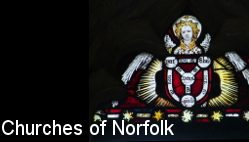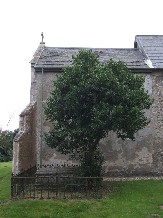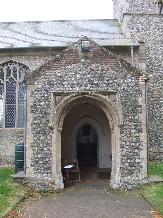| |
|
St
Michael, Braydeston
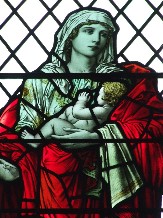 |
|
And
so we came to Braydeston. It was the end of the
Historic Churches bike ride day 2007, and all
over England the welcomers were taking in the
sign boards, washing out the squash jugs and
putting the last of the biscuits back in the tin.
We had visited 19 churches so far; a modest
number, perhaps, on this day when virtually all
are open, but we had found the Anglicans of the
Yare Valley to be a particularly friendly bunch,
detaining us with their conversation and offers
of cups of tea. They seemed genuinely pleased to
see us, although this may well be because
ordinarily most of their churches are kept
locked, unlike the majority in Norfolk. We had seen
Braydeston off on its gentle hilltop several
times during the day, particularly from Blofield,
where the great tower is less than half a mile
from Braydeston's little boxy one. But that is as
the crow flies, or the rambler walks, or the 19th
century Rector plods on his horse from one Divine
Service to another. To get from one to the other
by car, it is necessary to go out along the
narrow, doglegging lanes between fields already
ploughed, a smell of earth and the gathering
coldness of a late summer afternoon.
|
Braydeston
is one of those churches that few people visit, I would
hazard a guess. It isn't particularly well-known for
anything historic or interesting, and the setting is so
lonely that it is unlikely too many pilgrims or strangers
turn up to rattle at its locked door in frustration.
We came
down the track and parked, and a nice lady came out to
the gate to welcome us. You could sense that she was one
of those stalwarts of rural churches. These are the
people who count the collection, make sure the gutters
are cleaned out, fill in the health and safety forms,
organise the flower rota, and so on. They are the reason
why some rural medieval churches look as if they have a
busy life, and yet others have been abandoned. It often
has little to do with the size of the village, or the
number of people in the congregation. Ultimately, it is
about the commitment of a small number of people. God
help their churches when they go.
As it
turned out, this energetic lady had also written the
guidebook, and was very knowledgeable about her building.
St Michael rides its gently sloping hillside like a great
ship, the chancel lifting out of the waves. There was
obviously once an aisle on the south side, and although
there is the ghost of a Norman window on the north side,
the church looks mostly the work of the 13th century. For
a moment, you might think the same of the rather stark
tower, but in fact it appears to be the result of a
bequest in the late 15th century.
The
interior is rather narrow, and in the late afternoon
there was not much light getting inside. But the east
window, depicting Faith, Hope and Charity, is excellent,
and provides a lovely focus for worship. It was installed
as a war memorial in the 1920s.
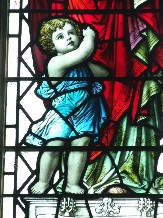 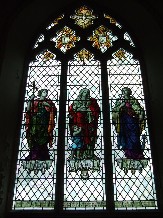 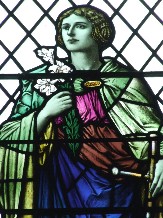
There was
quite an early 19th century restoration here, and it is a
restrained one, most fitting in this quiet place. The
most unusual feature is the stumpy font; the top part is
an octagonal bowl in the Decorated style, probably on the
eve of the Black Death, but the pedestal is a huge thing,
as wide as the bowl. I couldn't make out if they were two
separate pieces of stone. Is it original, or was it added
later to replace a collonade?
The little
screen is delicately carved, and a beautiful pelican in
her piety plucks at her breast to feed her chicks with
her own blood. On the wall beside it is a reminder of
this building's preaching house days, the stand for the
hourglass which made sure ministers didn't skimp on the
sermon. The simplicity of the interior makes the few
details stand out, including the handful of memorials;
rather sad ones, I am afraid. One is to two of the sons
of the Reverend Thomas Drake, who, in 1830, were
drowned by the upsetting of a boat at Langley in this
neighbourhood. It seems that their father was
already dead, for this humble tablet to commemorate
the melancholy event is erected by Martha Stewart, relict
of the above. Further to the west is a reminder of a
tragedy of almost a century later. Walter Meire, the 25
year old son of Walter and Hannah Meire of Verne House in
Brundall, was killed in action at the Battle of Loos
in September 1915. His body was never found, and he is
remembered on the Loos memorial. A simple wooden plaque
remembers the two boys from the parish killed in World
War Two.
It was all
lovely and interesting, a real touchstone down the long
generations of the parish of Braydeston.
I stood
outside, and looked out across the rolling fields towards
Blofield's tower. This was the end of my fourth Historic
Churches bike ride day in Norfolk, and by chance it
happened that Braydeston was my 700th Norfolk church.
There will be many more to come, but so far it has been a
privilege to immerse myself in this great treasure house
of a county's faith and history, what the writer Simon
Jenkins has called the greatest folk museum in the world.
If we are in the last days of the Church of England - and
its demise has been greatly exaggerated, of course - what
will happen to these wonderful buildings? I thank God
that there is a greater will to preserve them than there
was in the 1960s, for example.
19th
century philosophers argued that Faith would die; but of
course, this hasn't happened, at least not yet. Many of
the Christian denominations are undergoing unprecedented
growth, and people are forever 'surprising a hunger in
themselves' to seek out holiness. And there are new
religions; consumerism, hedonism and humanism, to name
but three, which may seem evil in their ways to
Christians, but which are eagerly reached for by those
seeking to satisfy the emptiness in their lives. And what
of the future? As well as changing patterns within its
own sphere, Christianity is going to have to cope with
the emergence of popular scientific atheism as a real
threat. For the first time since the days of Communist
Russia and Nazi Germany, we regularly have philosophers
and psychologists appearing in the media to tell us that
our Faith is a form of mental illness, that bringing up
our youngsters in the Christian tradition is a form of
child abuse, and that the battle between good and evil
will be fought with genetics. God help us if these people
ever achieve political power.
Meditating
on this rather depressing development, I wondered what a
medieval Braydestoner would have seen if he had looked
out towards Blofield on a day like this, perhaps in the
early years of the 16th century. It would have looked
much the same, I suppose. There would have been fewer
trees, the fields would have been smaller, and there
would have been more people on them, for the annual
ploughing took far longer then than it does now.
What would
he have felt? The same cooling, evening breeze coming
from the east as me, perhaps. What would he have smelt?
the same sharpness of the cloven earth, the sweet
sourness of the leaves begining to turn, the year
beginning to wind down. And what would he have heard?
| It
was nearly six o'clock. I imagined the angelus
bell, which has not rung at Braydeston for almost
half a millennium, jangling out its brisk trot
across the fields, and the ploughing workers
pausing for a moment to stand - not in prayer
exactly, more in an attitude of meditation, a
moment to recollect who they really were, and
that there was more to life than ploughing and
sowing and reaping and birth and death and the
eternal struggle to survive. That they were, in
fact, God's People. And then
they would return to their work, shadowy figures
now in the deepening mist, as other distant bells
took up the call, further and more distant, all
the way across lost Catholic England.
|
|
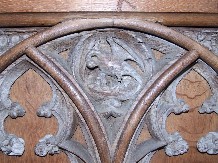 |
|
|
|
